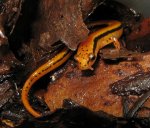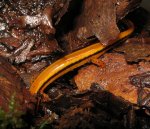taherman
Caudata.org Donor
- Joined
- Aug 24, 2007
- Messages
- 394
- Reaction score
- 44
- Points
- 28
- Location
- Whitehouse, OH
- Country
- United States
Just a couple of photos of my E. wilderae at home. I have a group of several young adults collected as metamorphs and larvae last summer. This male is absolutely spectacular, almost immaculately spotless and a luminous golden orange color. Photos don't do it justice. The others are pretty too, but not quite this nice.
Hopefully they'll breed like rabbits!
-Tim
Hopefully they'll breed like rabbits!
-Tim


